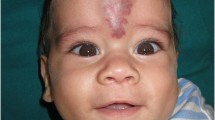Abstract
Introduction
Sinus pericranii (SP) is a rare vascular malformation characterized by abnormal communication between the intracranial and extracranial venous systems [1]. Sinus pericranii is most commonly seen in the distribution areas of the superior sagittal and transverse sinuses [2]. There are no uniform criteria for the etiology, pathogenesis, diagnostic criteria, treatment options, or prognosis of sinus pericranii [3].
Case description
In this paper, we present the diagnosis and treatment of a child admitted to our neurosurgery department in 2019 with rapidly growing frontal sinus pericranii, as well as the 3-year postoperative follow-up.
Discussion
The authors summarize the clinical presentation characteristics, diagnosis and treatment methods, and prognosis of this disease using relevant domestic and international literature to improve clinicians’ understanding of this disease.
Conclusion
It is rare to see a significant growing of the sinus pericranii within a short period, and the mechanism of their occurrence needs to be further explored.






Similar content being viewed by others
Data availability
The data used to support the findings of this study are available from the corresponding author upon request.
References
Fujimoto Y, Ishibashi R, Maki Y, Kitagawa M, Kinosada M, Kurosaki Y, Ikeda H, Chin M (2021) A simple surgical technique for pediatric sinus pericranii: intraoperative manual compression of a major shunting point. Pediatr Neurosurg 56(3):286–291. https://doi.org/10.1159/000514478
Pavanello M, Melloni I, Antichi E, Severino M, Ravegnani M, Piatelli G, Cama A, Rossi A, Gandolfo C (2015) Sinus pericranii: diagnosis and management in 21 pediatric patients. J Neurosurg Pediatr 15(1):60–70. https://doi.org/10.3171/2014.9.peds13641
Akella SS, Shah J, Barmettler A (2019) Sinus pericranii in the upper eyelid: diagnosis and management guidelines. Orbit 39(6):422–425. https://doi.org/10.1080/01676830.2019.1692874
Chen KS, Montaser A, Ashour R, Orbach DB (2020) Intracranial venous malformations: incidence and characterization in a large pediatric cohort. Interv Neuroradiol 27(1):6–15. https://doi.org/10.1177/1591019920943752
Goffin J, MacKenzie SA, Tallur KK, Kaliaperumal C (2018) Sinus pericranii: long-term outcome in a 10-year-old boy with a review of literature. BMJ Case Rep. https://doi.org/10.1136/bcr-2017-223631
Almujaiwel N, Alsager G, Almubarak AO, Ajlan A (2020) Sinus pericranii complicated by hydrocephalus: case report and literature review. World Neurosurg 139:238–241. https://doi.org/10.1016/j.wneu.2020.04.081
Ryu JY, Lee JH, Lee JS, Lee JW, Lee SJ, Lee JM, Lee SY, Huh S, Kim JY, Hwang SK, Chung HY (2020) Combined treatment of surgery and sclerotherapy for sinus pericranii. Arch Craniofacial Surg 21(2):109–113. https://doi.org/10.7181/acfs.2019.00521
Tyrell R, Limoges N, Kestle J, Gociman B, Siddiqi F (2020) Sinus pericranii in posterior cranial vault distraction. J Craniofacial Surg 31(7). https://doi.org/10.1097/scs.0000000000006642
Bouali S, Maatar N, Ghedira K, Boubaker A, Jemel H (2017) Spontaneous involution of a sinus pericranii. Childs Nerv Syst 33(9):1435–1437. https://doi.org/10.1007/s00381-017-3532-9
Funding
This study was supported by the Natural Science Foundation of Hebei Province, China (Grant No. H2022206078).
Author information
Authors and Affiliations
Contributions
Dr. Yuchen Sun: study concept and design, participation in surgery, manuscript writing. Dr. Binglei Wang: outpatient follow-up. Dr. Huijuan Wang: critical revision of the manuscript.
Corresponding author
Ethics declarations
Ethical approval
This study complies with all institutional guidelines regarding human subjects.
Consent to participate
Informed consent was obtained from the patient’s guardian.
Consent for publication
All authors read and approved the final manuscript and consent for publication.
Conflict of interest
None of the authors has any potential conflict of interest.
Additional information
Publisher's Note
Springer Nature remains neutral with regard to jurisdictional claims in published maps and institutional affiliations.
Rights and permissions
Springer Nature or its licensor (e.g. a society or other partner) holds exclusive rights to this article under a publishing agreement with the author(s) or other rightsholder(s); author self-archiving of the accepted manuscript version of this article is solely governed by the terms of such publishing agreement and applicable law.
About this article
Cite this article
Sun, Y., Wang, B. & Wang, H. Rapidly growing sinus pericranii within a short period: a case report. Childs Nerv Syst 39, 1679–1683 (2023). https://doi.org/10.1007/s00381-023-05864-w
Received:
Accepted:
Published:
Issue Date:
DOI: https://doi.org/10.1007/s00381-023-05864-w




